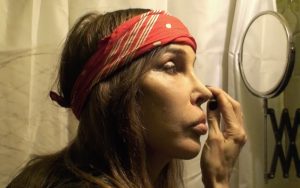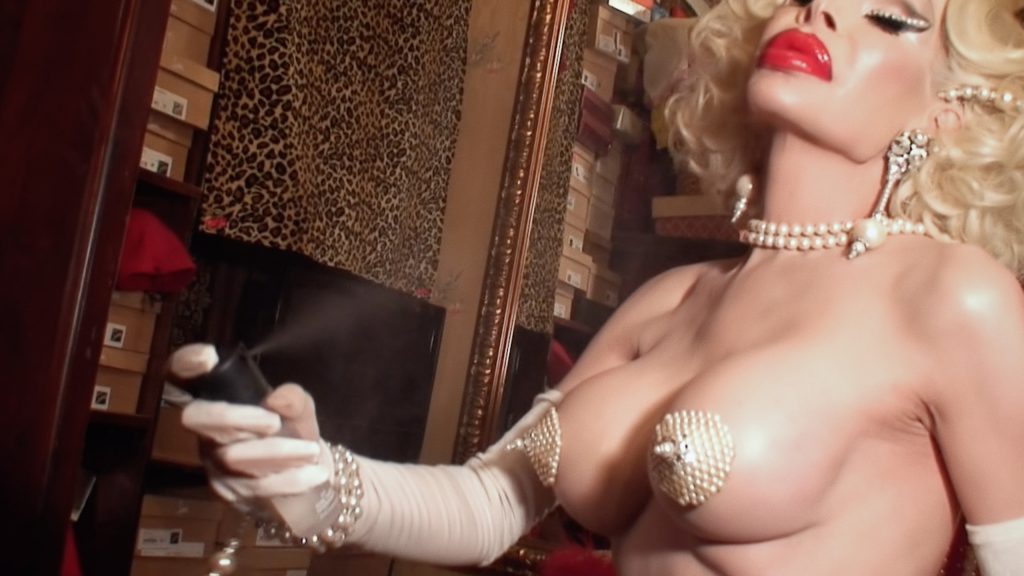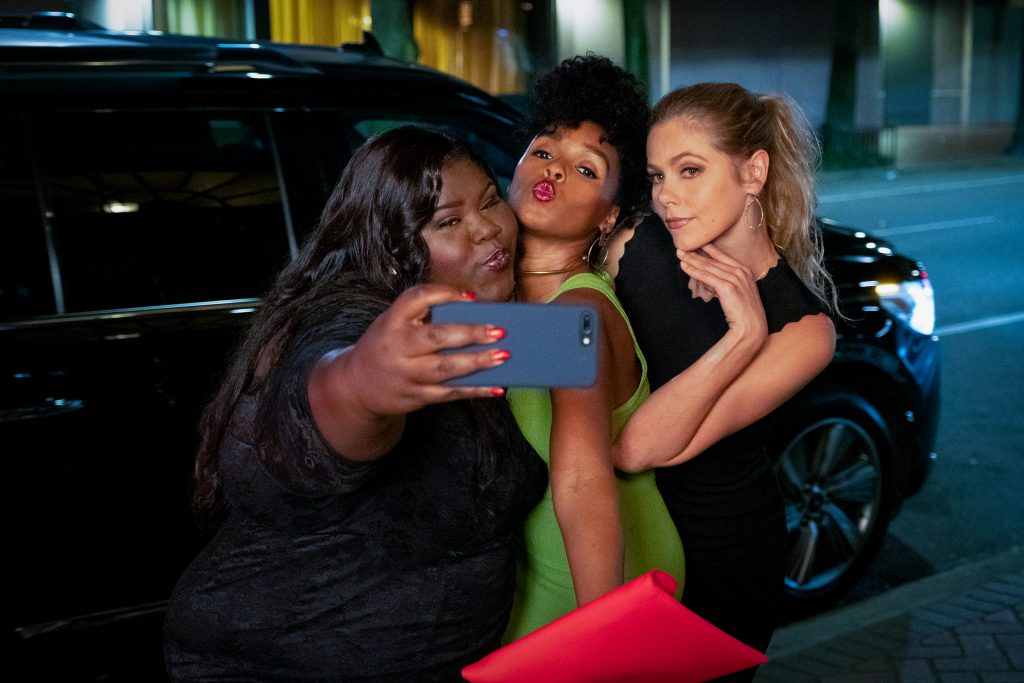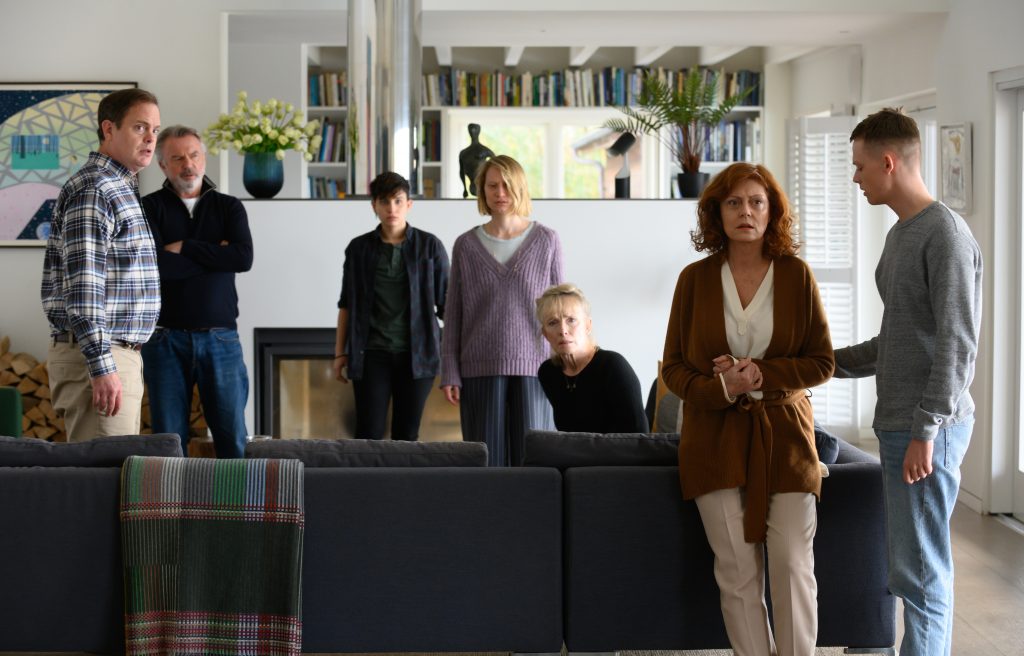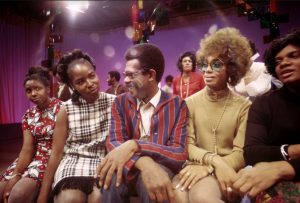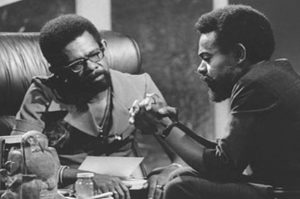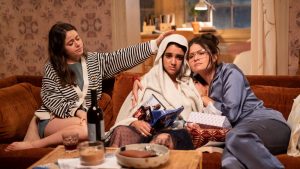September 18, 2020
by Carla Hay
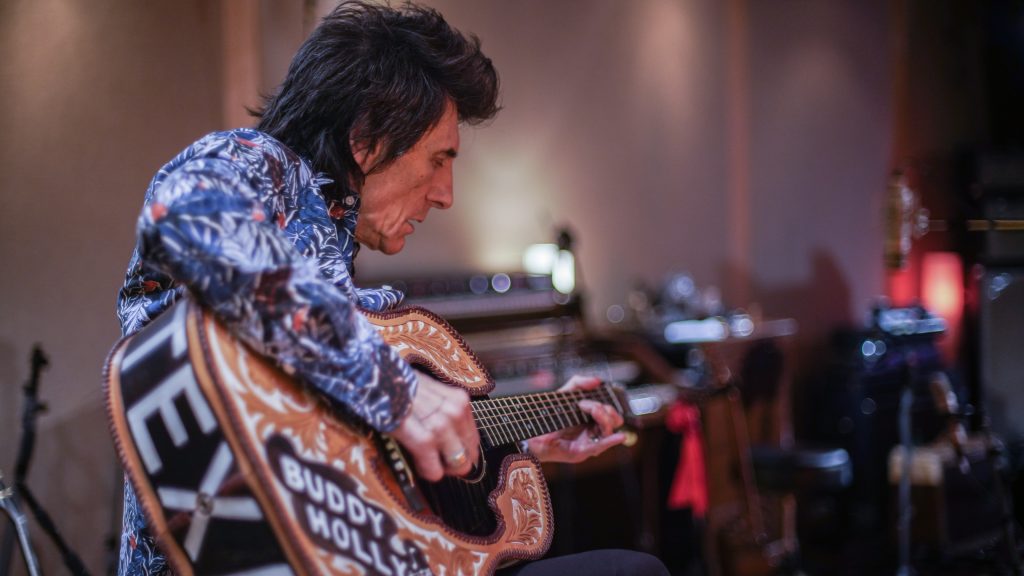
“Somebody Up There Likes Me” (2020)
Directed by Mike Figgis
Culture Representation: This documentary about Rolling Stones lead guitarist Ronnie Wood features Wood and an all-white group of people (mostly British) who talk about Wood, his artistic accomplishments and his personal life.
Culture Clash: Wood is candid about problems he’s had in his life, including his drug addiction and alcoholism.
Culture Audience: Besides the obvious target audience of Rolling Stones fans, “Somebody Up There Likes Me” will appeal to people who like survivor stories of people from the classic rock era.
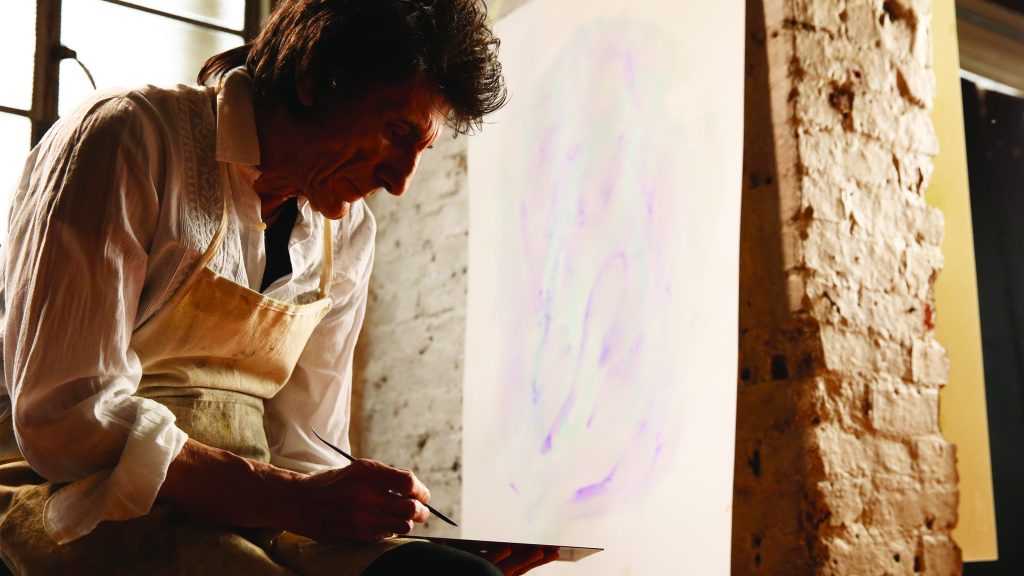
Considering the copious amount of books, news reports, feature articles and documentaries about the Rolling Stones, there really isn’t a whole lot that can be revealed about the band that hasn’t already been covered. The authorized documentary “Somebody Up There Likes Me” (directed by Mike Figgis) takes an engaging but not particularly insightful look into the life of Rolling Stones lead guitarist Ronnie Wood, who’s been in the band since the mid-1970s.
Wood has two memoirs (2008’s “Ronnie” and 2017’s “Ronnie Wood: Artist”) and an ex-wife (Jo Wood) who wrote her own 2013 memoir about their relationship, so the documentary is more of a snapshot of his life, rather than an in-depth portrait. Speaking of portraits, about half of the documentary is about Ronnie as a painter/illustrator. There’s a lot of screen time devoted to showing him doing hand-drawn portraits and talking about art and paintbrushes with fellow artist Damien Hirst, one of Ronnie’s closest friends. (Ronnie’s current and third wife Sally is one of his portrait subjects.)
This isn’t a biographical documentary that takes the conventional format of telling a life story in chronological order, from birth to when the documentary was filmed. Most of the footage involves just following Ronnie around and showing what he happened to be doing at the time. The “talking head” interviews are also selective: only a handful of people in Ronnie’s inner circle, including his wife Sally, friend Hirst, Rod Stewart (who used to be in the Jeff Beck Group and in the Faces with Ronnie), Rolling Stones lead singer Mick Jagger, Rolling Stones rhythm guitarist Keith Richards and Rolling Stones drummer Charlie Watts.
There also isn’t a lot of digging into Ronnie’s pre-fame life. However, Ronnie (who was born in 1947 in London) does mention his dysfunctional upbringing in his family of musicians. He describes his father Arthur and two older brothers Art and Ted as alcoholics. (All of them were jazz and blues musicians.) Art and Ted were also painter artists, and Ronnie has said in many interviews how much his older brothers influenced him.
Ronnie remembers that when he was a child, his family wouldn’t know which garden his father Arthur would be passed out in if they couldn’t find him. This chronic alcoholic behavior worried his mother. Ronnie says that Arthur never abused the kids, but his frequent absences did have a negative effect on the family. “He would be damaging by not being there.” Ronnie comments.
Considering that addiction can be inherited, it’s little wonder that Ronnie became a hardcore drug addict and alcoholic too. He’s already been candid about it many interviews and in his memoirs. His decadent past has also been extensively covered in the media. Therefore, the documentary isn’t interested in having Ronnie tell all the wild and crazy stories about himself that he already told years ago.
Ronnie got clean and sober in 2010, after Hirst and Ronnie’s son Jesse (who are also recovering alcoholics/addicts) did an intervention on Ronnie. But one addiction that Ronnie had a hard time quitting after that was nicotine. Ronnie had no choice to quit smoking after he was diagnosed with lung cancer in 2017. Luckily, the cancer was caught early enough where he could have surgery to correct the problem.
Ronnie says in the documentary that he used to smoke about 25 to 30 cigarettes a day. Now, when he goes for a medical checkup, the doctor tells him that he has lungs that look so healthy, it looks like he never smoked. “How’s that for a ‘get out of jail free’ card?” Ronnie quips. “Somebody up there likes me.”
If people are looking for a lot of Rolling Stones concert footage in this documentary, they won’t find it, probably because of licensing issues. There’s a brief clip of the Rolling Stones performing “When the Whip Comes Down” in 2018. But most of the on-stage footage is of Ronnie as a solo artist or archival footage of Ronnie in bands that he was in before he joined the Rolling Stones.
Therefore, when watching this documentary, expect to see quite a bit of Ronnie Wood and Friends, a bluesy rock group consisting of Ronnie and rotating group of singers and musicians. There’s footage of the group performing “Wee Hours” with Irish singer Imelda May, who’s interviewed in the film.
“Somebody Up There Likes Me” director Figgis appears in the film as an interviewer, which is a documentarian technique that mostly works for this film. During the times it doesn’t work, Figgis comes across as too chummy or star-struck, as if there was an off-camera agreement that he wasn’t going to ask questions that are too probing.
And, for the most part, the questions are fairly lightweight. But Ronnie has such a charismatic personality that he gives answers that tell more than the question asks. He comes across as someone who’s lived a pretty crazy life and has come to terms with a lot of his mistakes.
In one scene, when Ronnie gets a tarot card that reads “Fatal Impudence,” Figgis asks if those words could apply to Ronnie’s life. Ronnie replies, “I’m like Yogi Berra. You come to a fork in the road, take it.”
And when Figgis asks what’s the biggest “fork in the road” for Ronnie, Ronnie says, “It has been my love life. I’ve totally gone for risk.” Figgis asks, “Has that gotten you into a lot of trouble?” Ronnie quips, “It’s gotten me into a lot of pleasure.”
The tabloids have covered the numerous affairs and womanizing in his life before Ronnie married Sally, so the documentary doesn’t rehash all of that. However, it wasn’t all fun and games, since Ronnie admits a lot of people got emotionally hurt along the way. And he also opens up a little bit about the trauma he experienced when he says his “first love” (a girlfriend named Stephanie) tragically died in a car accident.
Ronnie also talks about the importance of apologizing to people he offended, which is a common requirement for people who’ve been in rehab. “You want the situation to resolve without any disastrous consequences,” he adds.
He also admits that he’s got issues with getting older. “I never got past 29 in my head. To be 70 is so weird. It’s so surreal. I didn’t get time would go so quickly. You almost feel cheated that time has gone by.”
In a very “Behind the Music” documentary formula of the rise, fall and redemption of rock stars, Ronnie’s marriage to his wife Sally (whom he married in 2012) is credited with helping him be an upstanding, clean and sober family man. Ronnie and Sally welcomed twin daughters Alice and Gracie in 2016. He has four other kids from his previous two marriages. Sally comments in the documentary: “Ronnie’s a happy person. He’s better sober.”
As for Ronnie’s former and current band mates, Stewart mostly remembers the first gig that the Jeff Beck Group played at the Fillmore East, the band was the opening act for the Grateful Dead. “We wiped the stage with them,” Stewart boasts. He has not-so-fond memories of Peter Grant, who was the Jeff Beck Group’s manager at the time. According to Stewart, Grant was a “bully” who preferred Beck over the other members of the band.
The archival performance footage in the documentary include the Birds (one of Ronnie’s early bands) performing “That’s All I Need You For” in 1964; the Jeff Beck Group performing “Plynth (Water Down the Drain)” in 1967; and the Faces performing “Stay With Me” in 1974. There’s also new documentary footage of Ronnie doing an acoustic performance of the Faces’ 1973 hit “Ooh La La.”
Ronnie shares his often-told story of seeing the Rolling Stones for the first time in 1963, and the band’s performance was inside a tent. Ronnie says that experience changed his life, and he knew from that moment he wanted to be in the Rolling Stones. It took 12 years for that to happen, when Ronnie was asked to be the lead guitarist for the Rolling Stones during their 1975 tour, after lead guitarist Mick Taylor abruptly quit the Rolling Stones.
Ronnie was described at the time as being “on loan from the Faces” during that 1975 tour, but the writing was on the wall, since the Faces were on the verge of breaking up that year anyway. Ronnie officially became a member of the Rolling Stones in 1976, but it wasn’t 1990 that he was became a full business partner in the band. The documentary doesn’t mention all of the behind-the-scenes legal wrangling that Ronnie went through to get to becoming a full band partner in the Rolling Stones. He talks about it in his memoir “Ronnie.”
Jagger says of Ronnie joining the Rolling Stones: “We really wanted Ronnie. He fit in very quickly.” The gig was so coveted that Rolling Stones drummer Watts says that Led Zeppelin guitarist Jimmy Page even auditioned to be in the Stones, even though Led Zeppelin was the biggest band rival to the Rolling Stones at that time.
Richards, who is the Rolling Stones band mate who’s closest to Ronnie, says in the documentary about Ronnie joining the band: “It was pre-destined, in a way.” And he describes their longtime friendship: “We’ve always had a friendly rivalry … The thing is with Ronnie, you’re such good mates, you can call each other any name under the sun, and it doesn’t matter.”
Jagger says the Rolling Stones benefited from Ronnie’s impish sense of humor on stage too: “These arena shows became slightly more humorous because of Ronnie’s personality. Ronnie brought a sense of fun to it.”
But there were dark periods for Ronnie too, particularly his longtime drug addiction (mostly to cocaine) and alcoholism. Through the ups and downs, rehab stints and relapses, “Mick never gave up on him,” says Watts. And when your best friend in the band is Richards (another notorious drug addict/alcoholic, who’s only admitted to quitting heroin), it’s no wonder that it took to so long for Ronnie to get clean and sober.
Avid fans of the Rolling Stones won’t learn anything new from watching this documentary. However, people who aren’t familiar with Ronnie might be surprised at how multifaceted he is outside of the Rolling Stones. “Somebody Up There Likes Me” goes out of its way to show the process of Ronnie creating some of his artwork, because it’s clear that he wants to be known as more than just a musician. This documentary doesn’t go deep into Ronnie’s psyche, but it scratches just enough beneath his public image for people to have a better understanding of who he is.
Eagle Rock Entertainment released “Somebody Up There Likes Me” in select U.S. virtual cinemas on September 18, 2020. The movie’s release on digital, Blu-ray and DVD is on October 9, 2020. “Somebody Up There Likes Me” was released in the United Kingdom in 2019.



